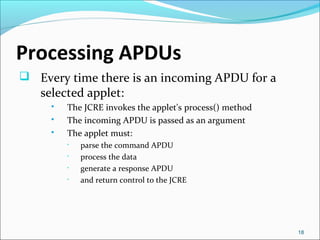Java card technology
- 2. Presentation Agenda Identify Java Card Technology Identify Elements of Java Card applications Communicating with a Java Card Applet Java Card Language Limitations 2
- 3. Introduction The first Java Card was introduced in 1996 by Schlumberge’s card division which later merged with Gemplus to form Gemalto Java Card refers to a technology that allows Java-based applications to be run securely on smart cards. Java Card gives the user, the ability to program the device and make them application specific. 3
- 4. Smart Cards A smart card is a plastic card that contains an embedded integrated circuit (IC) Examples: Our very Own T-Card! Credit Cards Cell Phone SIM Cards 4
- 5. Java Cards are Smart! How?? They store and process Information Smart Cards can be used to add authentication and secure access to information systems that require a high level of security 5
- 6. Properties Highly secure Tampering with one, results in destruction of the information it contains Does not contain a battery. Becomes active when connected with a card reader Comes in two forms: Contact Contact less 6
- 7. Contact Java cards work by communicating via physical contact between a card reader and the smart card. Contact-Less smart cards communicate by means of a radio frequency signal, with a typical range of less than 2 feet. 7 Contact & Contact-Less
- 8. Features of Java Card SUPPORTED NOT SUPPORTED • Small primitive data types: boolean, byte, short. • One dimensional arrays. • Object oriented features: inheritance, virtual methods, dynamic object creation, overloading, scope. • Large primitive data types: long, double, float. • Characters, strings. • Multidimensional arrays. • Dynamic class loading. • Garbage collection. • Threads. • Object Cloning 8
- 9. Elements of Java Card Application A complete Java Card application consists of : A back-end application A host (off-card) application An interface device (card reader ) The on-card applet User credentials 9
- 10. 10
- 11. The Back-End Application and Systems Provides connectivity to security systems Example: In an electronic payment system, the back-end application could provide access to credit card and other payment information 11
- 12. Card Reader’s side Consists of two parts: Host Application Card Acceptance Device Example Think of an ATM machine Host Application, being the Computer, provides interaction with the system. Card Acceptance Device, where you insert a debit card. 12
- 13. The Card-Side Elements: One or more Java Applets Card’s operating System Java Card Runtime Environment (JCRE) • Java Card Virtual Machine • Java Card Framework and APIs 13
- 14. Developing a Java Card Applet Write the Java source Compile your source Convert the class files into a Converted Applet (CAP) file (binary representation of classes and interfaces) Verify that the CAP is valid (structure, valid bytecode subset, inter-package dependencies) Install the CAP file 14
- 15. Communicating with a Java Card Applet Two methods for communicating with Java Card Applet: 1. Fundamental message-passing model 2. Java Card Remote Method Invocation (JCRMI) which is a subset of J2SE RMI! 15
- 16. 16
- 17. The Message-Passing Model All Java Card applets extend the Applet base class and must implement the install() and process() methods JCRE calls install() when installing the applet, and process() every time there is an incoming APDU for the applet APDU: A logical data packet that's exchanged between the CAD and the Java Card Framework (It Is considered as the center piece for the Message-Passing Model) 17
- 18. Processing APDUs Every time there is an incoming APDU for a selected applet: The JCRE invokes the applet's process() method The incoming APDU is passed as an argument The applet must: • parse the command APDU • process the data • generate a response APDU • and return control to the JCRE 18
- 19. The Command APDU CLA - Class of Instruction INS - Instruction Code P1,P2 - Parameters Lc - Length of the field Le - Maximum Response Length 19
- 20. The Response APDU SW1 : Status word1 SW2: Status word2 20
- 21. The Java Card RMI (JCRMI) The second communication model relies on a subset of the J2SE RMI distributed-object model a server application creates and makes accessible remote objects a client application obtains remote references to remote objects, and then invokes remote methods on them. 21
- 22. Benefits Hardware Independence: Java Card is independent of the type of hardware used and it can be run on any Smart card processor (8 bits or 16 bits or 32 bits ) Ability to store and manage many applications Applets developed with Java Card technology will run on any Java Card technology-enabled smart card, independently of the card vendor and underlying hardware. 22
- 23. Applications Subscriber Identity Module (SIM) cards, used in cell phones on most wireless networks Government and health-care identity cards Financial cards supporting both online and offline transactions Smart tickets for mass trans 23
- 24. 24
- 25. 25

























